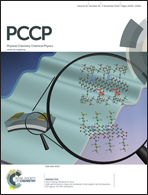Theoretical study of the mechanisms and kinetics of the reactions of hydroperoxy (HO2) radicals with hydroxymethylperoxy (HOCH2O2) and methoxymethylperoxy (CH3OCH2O2) radicals†
Abstract
The reactions of hydroperoxy radicals with hydroxymethylperoxy and methoxymethylperoxy radicals were studied using the hybrid density functional theory and the coupled-cluster theory with complete basis set extrapolation. In contrast with the unsubstituted alkylperoxy reactions, it was found that OH-substitution has a significant effect on the reaction mechanism. Several hydrogen bonding reaction precursors exist at the start of the reaction. The reaction pathways show a strongly anisotropic character. The preferred transition states are four-, five-, six-, or seven-membered cyclic structures. The predicted rate coefficients are expressed as k(T) = 8.48 × 10−24T3.55e2164/T + 2.37 × 10−29T4.70e3954/T cm3 molecule−1 s−1. Based on the available experimental data in the temperature range 275–333 K, the theoretical and experimental results are in agreement with a relative average deviation of only 8%. The nascent products at low and high temperatures are hydroperoxide molecules and hydroxyl radicals, respectively. A potential source has been found for the production of formic acid and new insights into the experimental observations are presented.


 Please wait while we load your content...
Please wait while we load your content...